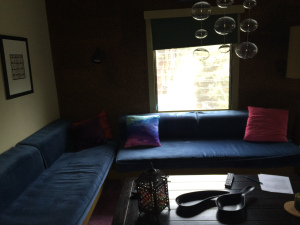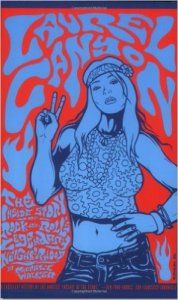Blog Post 1- Greetings from LA
Blog Post 2- My "Pad
Part of my plan for this trip was to stay in the legendary Laurel Canyon neighborhood where so many of rock’s luminaries hung out in the 60s and 70s. One think I didn’t count on was the somewhat harrowing drive to the residence…after all, it is a canyon! Nothing like my colleague Drew Proctor faced on his trips I’m sure but, nonetheless, a bit nerve-wracking. Here are some pics of my pad in Laurel Canyon.
Blog Post 3- The Research Begins
On my first full day, I began by visiting the Canyon Country Store, a fixture of the Laurel Canyon area since its construction in the late 1920s. Although the store is very close to where I’m staying, I chose to drive because of the steepness and narrowness of the streets. As I pulled out from my house, I noticed this beautiful bush which you see all over this area…not sure of the name.
The Canyon Country Store began as a hunters lodge and was frequented by such early Hollywood Legends as Clara Bow and Errol Flynn and escape artist Harry Houdini. In the 60s and early 70s, folk and rock musicians such as David Crosby, Stephen Stills, Frank Zappa, Cass Elliot, Joni Mitchell and Jim Morrison who frequented the Laurel Canyon area hung out at this establishment and did drug deals in the parking lot. Some of the locals have been in the area since that time and are glad to share their stories. Today, I was just getting “the lay of the land” as I sat and had a snack, but in the process heard one old timer sharing a story regarding the Rolling Stones.
Following my time at the store, I attempted to spot the site of the Laurel Tavern at the corner of Laurel Canyon Blvd. and Lookout Mountain. This log cabin was a resort in the early 20th century complete with a cavernous living room and a bowling alley in the basement. Tom Mix, the early star of silent Western films and friend of Wyatt Earp, stayed there for a short period, and Frank and Gail Zappa moved in during the 60s. Though neither of these two were drug users, many of the canyon denizens would frequent the house. I did find the intersection, which also includes Harry Houdini’s estate but was unable to get a picture because of the dense, fast traffic. Maybe I’ll find another way later in my stay.
On to the UCLA school of music. UCLA is a beautiful campus, as you can see from the two pics of esplanades below, the second just outside the Schoenberg Hall.
From what I can gather, the school of music is the Herb Alpert School of Music that is housed in a building named Schoenberg Hall (after the famous early 20th century composer). Also, within its walls, however, is the Evelyn and Mo Ostin Music Center, donated by music industry executive and philanthropist Morris “Mo” Ostin and housing state of the art recording facilities, an internet-based music production center and a cafe and social space for students (eat your hearts out, Hill College music majors!).
On my way to the music library, I saw a few interesting items. First, on a monitor in the hallway, was the picture below of GRAMMY winning arranger and composer Quincy Jones and singer-songwriter Lionel Richie taking part in a symposium in 2013 as part of a Music Industry course in this new facility. Second, and this has little to do with my area of research but everything to do with my passion for jazz, was the Thelonius Monk Institute for Jazz Performance.
Finally, thanks to the help of the Assistant to the Director of the Herb Alpert School of Music, I located the Walter H. Rusamen Music Library. The staff were very welcoming and helpful, so I was able to get right down to work, beginning with examination of a book on the punk rock scene in LA in the 70s. The pictures below are of this library, which I will be visiting on several more occasions during my stay. The library houses a large collection of popular sheet music covering much of the material from my American Popular Music course. Also, note in the far back corner a grand piano.
As I left UCLA in search of a restaurant I never found, I did come across this very interesting mural of “The Beatles” off Santa Monica Blvd.
Also, as I was returning to Laurel Canyon, I took this picture of the incredibly precarious locations many of the Laurel Canyon residents have chosen for their abode>
I ended my day in a very interesting way. As I sat out on the porch of my “crash pad”, I reread selections from Laurel Canyon: The Inside Story of Rock and Roll’s Lengendary Neighborhood, realizing that all that I was reading had taken place right here where I sat. I end this post with a quote from the first chapter of this book, titled “So You Want To Be A Rock-and-Roll Star?”:
Folk rock would prove more popular and remunerative than either genre had separately, and it presaged the truly humongous folk-country-rock “L.’A. Sound”, perfected by Crosby, Stills & Nash, the Eagles, Jackson Browne, America, Linda Ronstadt, and others, which would dominate from the late 1960s to the late ’70s and utterly transform the record industry. But it all started in 1965 with the Byrds. For Hillman [Chris Hillman, who with David Crosby and two others formed The Byrds] and his bandmates, as well as for the eucalyptus-scented Los Angeles canyon where Hillman would soon reside, life wound never be the same.”





























Comments
Post a Comment